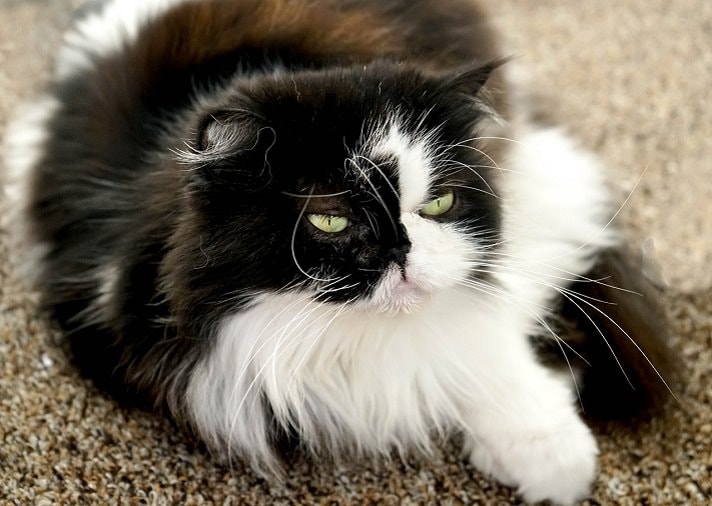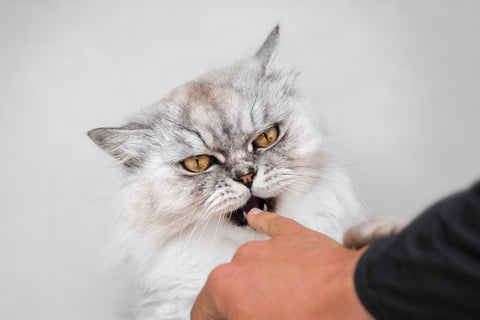If you’re a new Persian cat owner and looking for tips on potty training, you’ve come to the right place. This article will give you some helpful advice on how to successfully potty train your Persian cat. From establishing a consistent routine to using the right litter box, we’ll cover all the essentials to make the process as smooth as possible. So, let’s get started and ensure that your fluffy friend knows exactly where to do their business!
1. Understanding Persian Cats
Persian cats are one of the most popular and beloved breeds among cat enthusiasts. They have a rich history and unique traits that make them stand out in the feline world. In this section, we will delve into the history and origin of Persian cats, their physical characteristics, temperament and personality, grooming needs, and common health issues.
1.1 History and Origin
Persian cats have a long and storied history that dates back to ancient times. They are believed to have originated in Persia (modern-day Iran) and were highly regarded by Persian royalty and nobility. These regal cats were eventually introduced to Europe in the 17th century and gained popularity among cat lovers. Over the years, Persian cats have become synonymous with elegance and beauty.
1.2 Physical Characteristics
One of the most distinctive features of Persian cats is their luxurious and flowing coat. They have long and silky fur that requires regular grooming to keep it in top condition. Persian cats have a round face with large and expressive eyes, a short nose, and small ears. They have a sturdy and muscular build with a graceful and elegant posture. Persian cats come in a variety of colors and patterns, adding to their visual appeal.
1.3 Temperament and Personality
Persian cats are known for their laid-back and gentle personalities. They are often described as affectionate and loving companions. These cats enjoy a calm and peaceful environment and are not usually fond of loud noises or sudden movements. Persian cats are independent but also enjoy the company of their human family members. They make great lap cats and are known for their ability to relax and lounge for hours on end.
1.4 Grooming Needs
One of the most important aspects of caring for a Persian cat is grooming. Due to their long fur, Persian cats require regular brushing to prevent matting and tangling. Daily grooming sessions are recommended to keep their coat in good condition. In addition to brushing, Persian cats also need regular bathing to keep their fur clean and healthy. It is essential to use cat-specific grooming products and techniques to ensure the best results.
1.5 Common Health Issues
While Persian cats are generally healthy cats, they are prone to certain health issues. Some of the common health concerns in Persian cats include eye problems such as tear duct issues, dental problems, respiratory issues, and polycystic kidney disease. It is crucial for Persian cat owners to be aware of these potential health problems and schedule regular vet check-ups to monitor their cat’s health. Early detection and treatment are key in managing these conditions.
2. Potty Training Basics
Potty training is an essential aspect of cat ownership, including Persian cats. In this section, we will explore the basics of potty training your Persian cat, including the importance of potty training, choosing the right litter box and litter, setting up the training area, and introducing your cat to the litter box.
2.1 Importance of Potty Training
Potty training is crucial for both the well-being of your Persian cat and the cleanliness of your home. By teaching your cat to use a litter box, you provide them with a designated area to relieve themselves and maintain good hygiene. Potty training also helps prevent accidents around the house and can make your cat’s life more comfortable.
2.2 Choosing the Right Litter Box
When it comes to choosing a litter box for your Persian cat, there are a few factors to consider. Firstly, the litter box should be large enough to accommodate your cat comfortably. Persian cats are known for their larger size, so opting for a spacious litter box is ideal. Additionally, consider the height of the litter box to ensure easy entry and exit for your cat. It’s also important to choose a litter box that is easy to clean and maintain.
2.3 Finding the Right Litter
Selecting the right litter for your Persian cat is essential for successful potty training. Persian cats have sensitive noses, so choosing a low-dust and unscented litter is recommended. Clumping litter is often preferred by owners as it makes cleaning the litter box more convenient. Avoid scented litter as it may be off-putting to your cat and discourage them from using the litter box.
2.4 Setting Up the Potty Training Area
Creating a suitable potty training area for your Persian cat will help them understand where they should relieve themselves. Choose a quiet and low-traffic area in your home for the litter box. Ensure that the area is easily accessible for your cat and offers them privacy. It’s also important to keep the litter box away from your cat’s food and water bowls to maintain cleanliness.
2.5 Introducing Your Persian Cat to the Litter Box
Introducing your Persian cat to the litter box should be done gradually and with patience. Start by placing your cat in the litter box after meals or when they show signs of needing to relieve themselves. Encourage your cat to dig in the litter using their paws, as this mimics natural behavior. If your cat successfully uses the litter box, reward them with praise and treats to reinforce positive behavior.
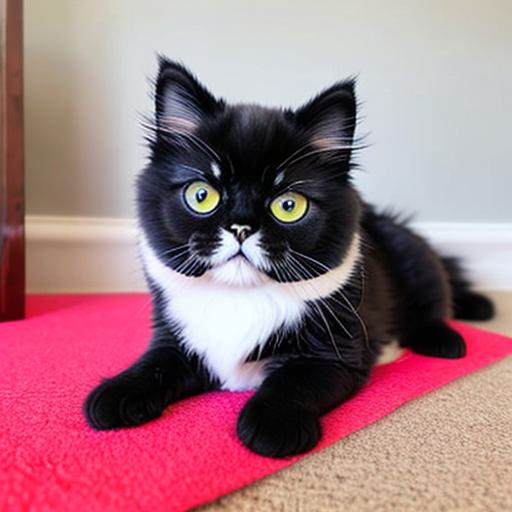
3. Signs Your Persian Cat is Ready for Potty Training
Knowing when your Persian cat is ready for potty training is essential for a successful training experience. In this section, we will explore signs that indicate your cat is ready for potty training, including age and development, behavioral cues, litter box digging, frequent bathroom trips, and accidents outside the litter box.
3.1 Age and Development
Persian kittens typically become ready for potty training around 8-10 weeks of age. At this stage, they are capable of controlling their bladder and have developed the physical abilities to use a litter box. It is important to note that individual cats may progress at different rates, so it’s essential to observe their behavior and readiness.
3.2 Behavioral Cues
Observing your Persian cat’s behavior can provide indications that they are ready for potty training. Look for signs such as sniffing the ground, scratching or pawing at the floor, or meowing with urgency. These behaviors suggest that your cat is searching for a suitable place to relieve themselves and can serve as cues for potty training.
3.3 Litter Box Digging
If your Persian cat shows an interest in digging or pawing at the floor or furniture, it may be a sign that they are instinctively trying to create a suitable space for elimination. This behavior can be redirected to the litter box during potty training.
3.4 Frequent Bathroom Trips
If you notice that your Persian cat is making frequent bathroom trips or taking longer periods inside the litter box, it can indicate their readiness for potty training. Cats naturally prefer a clean and odor-free litter box, so increased visits can be a sign that your cat is seeking out a suitable area to relieve themselves.
3.5 Accidents Outside the Litter Box
Accidents outside the litter box can be an indication that your Persian cat needs potty training. If you notice that your cat consistently eliminates in areas other than the litter box, it’s important to address this behavior promptly. Potty training can help redirect your cat to use the litter box consistently.
4. Step-by-Step Potty Training Guide
A step-by-step approach to potty training your Persian cat can ensure a smooth and successful training process. In this section, we will discuss the key steps involved in potty training, including choosing the right location, introducing the litter box, encouraging exploration, positive reinforcement, and dealing with accidents.
4.1 Step 1: Choosing the Right Location
Selecting a suitable location for the litter box is crucial for successful potty training. Choose a quiet and easily accessible area in your home that provides your Persian cat with privacy and comfort. Avoid placing the litter box in high-traffic areas or near food and water bowls.
4.2 Step 2: Introducing the Litter Box
Start by introducing your Persian cat to the litter box by gently placing them inside. Allow them to explore the box at their own pace and avoid forcing them into it. You can entice your cat to investigate further by using a small amount of unscented litter and encouraging them to dig and paw at it.
4.3 Step 3: Encouraging Exploration
To encourage your Persian cat to use the litter box consistently, make it a positive and rewarding experience for them. Offer treats and praise when they successfully use the litter box and gently redirect them to the box if they show signs of needing to relieve themselves elsewhere. Rewards and positive reinforcement can help establish good potty habits.
4.4 Step 4: Positive Reinforcement
Positive reinforcement plays a crucial role in potty training your Persian cat. Whenever your cat uses the litter box correctly, reward them with praise, treats, or playtime. This positive association will reinforce their understanding that using the litter box is a desirable behavior.
4.5 Step 5: Dealing with Accidents
Inevitably, accidents may happen during the potty training process. It’s important to stay calm and avoid punishing or scolding your Persian cat for accidents. Instead, clean up the mess promptly and thoroughly to remove any lingering odor. Using an enzymatic cleaner specifically designed for pet accidents can help eliminate odors effectively.
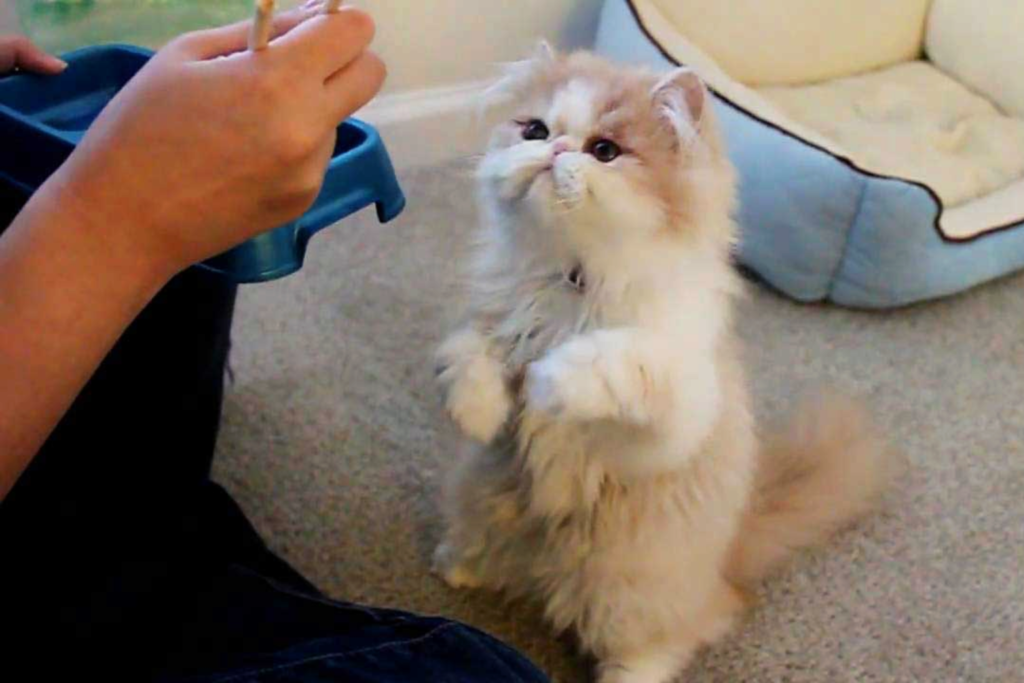
5. Tips for Successful Potty Training
Potty training your Persian cat requires time, patience, and consistency. In this section, we will provide some helpful tips to ensure a successful training experience, including consistency and routine, patience and positive reinforcement, avoiding punishment, cleaning and odor control, and monitoring health and veterinary support.
5.1 Consistency and Routine
Consistency is key when potty training your Persian cat. Stick to a regular schedule for feeding, playtime, and litter box cleaning. This routine will help your cat understand when to expect opportunities to use the litter box and establish good potty habits.
5.2 Patience and Positive Reinforcement
Potty training can take time, and it’s important to remain patient throughout the process. Be consistent with your training techniques and provide positive reinforcement when your Persian cat successfully uses the litter box. Encouragement and rewards go a long way in establishing desirable potty habits.
5.3 Avoiding Punishment
It’s crucial to avoid punishing or scolding your Persian cat for accidents or unsuccessful potty training attempts. Punishment can create anxiety and fear around the whole potty training process, making it more challenging to achieve the desired results. Instead, focus on positive reinforcement and redirection.
5.4 Cleaning and Odor Control
Maintaining a clean and odor-free litter box is essential for successful potty training. Regularly scoop the litter box and remove any waste to prevent odors from building up. Deep clean the litter box periodically and use an enzymatic cleaner to eliminate any lingering odors from accidents. A clean environment will encourage your Persian cat to continue using the litter box.
5.5 Monitoring Health and Veterinary Support
During the potty training process, it’s important to monitor your Persian cat’s health and behavior. If you notice any changes in their bathroom habits, such as frequent urination, straining, or blood in their urine, it’s crucial to seek veterinary support. These can be signs of underlying health issues that require prompt attention.
6. Troubleshooting Common Potty Training Issues
Potty training can sometimes pose challenges, but with the right approach, these issues can be resolved. In this section, we will address common potty training issues specific to Persian cats, including avoiding litter box aversion, addressing litter box anxiety, dealing with constipation or diarrhea, managing urinary tract infections, and handling spraying or marking behaviors.
6.1 Avoiding Litter Box Aversion
Litter box aversion can occur if your Persian cat has negative experiences associated with the litter box. To avoid this issue, ensure that the litter box is always clean and odor-free. Experiment with different types of litter to find the one that your cat prefers. Additionally, provide multiple litter boxes in different locations to give your cat options.
6.2 Addressing Litter Box Anxiety
Some Persian cats may experience anxiety or stress related to using the litter box. This can manifest in avoiding the litter box altogether or excessive scratching and digging. To address litter box anxiety, create a calm and quiet environment around the litter box area. Consider using pheromone diffusers or calming sprays to reduce anxiety in your cat.
6.3 Dealing with Constipation or Diarrhea
Constipation or diarrhea can interfere with potty training. If your Persian cat is experiencing either of these issues, it’s important to address the underlying cause. Evaluate their diet to ensure it is appropriate and consult with your veterinarian for guidance. Increasing fiber intake, providing ample hydration, and making dietary adjustments can help regulate their bowel movements.
6.4 Managing Urinary Tract Infections
Urinary tract infections (UTIs) can cause discomfort and lead to litter box aversion. If your Persian cat exhibits symptoms such as frequent urination, blood in the urine, or signs of pain, it’s essential to seek veterinary care. Prompt diagnosis and treatment of a UTI can help your cat recover and prevent any disruptions in their potty training progress.
6.5 Handling Spraying or Marking Behaviors
Spraying or marking behaviors can be a challenge during potty training. These behaviors are often linked to a cat’s territorial instincts or stress. Neutering or spaying your Persian cat can help alleviate these behaviors. Additionally, providing ample environmental enrichment, such as scratching posts and vertical spaces, can help redirect these instincts.
7. Transitioning from Potty Training to Full Independence
Once your Persian cat has successfully mastered potty training, it’s important to transition them to full independence. In this section, we will explore the steps involved in this transition, including gradual removal of potty training supplies, encouraging self-sufficiency, maintaining good potty habits, continued monitoring and reinforcement, and celebrating success.
7.1 Gradual Removal of Potty Training Supplies
Begin the transition to full independence by gradually removing the potty training supplies. Start by reducing the number of litter boxes to one and gradually phasing out any additional training aids or barriers you may have used. This gradual removal allows your Persian cat to adjust to the changes at their own pace.
7.2 Encouraging Self-Sufficiency
Encourage your Persian cat to become self-sufficient in their potty habits. Allow them to access the litter box whenever they need to relieve themselves, without any guidance or redirection. This independence reinforces their understanding of where and when to use the litter box.
7.3 Maintaining Good Potty Habits
Even after achieving full independence, it’s essential to continue maintaining good potty habits. Regularly clean the litter box, provide fresh litter, and monitor your Persian cat’s bathroom behaviors. Reinforce positive potty habits by providing rewards and praise when they consistently use the litter box.
7.4 Continued Monitoring and Reinforcement
While your Persian cat may be fully potty trained, it’s important to continue monitoring their bathroom behaviors and overall health. Any changes in their habits or the appearance of discomfort should be addressed promptly. Reinforce positive behaviors through continuous rewards, and redirect any inappropriate elimination outside the litter box.
7.5 Celebrating Success
Transitioning from potty training to full independence is a significant milestone for both you and your Persian cat. Celebrate this success by recognizing and rewarding their achievement. Offer treats, playtime, or special attention to reinforce their good potty habits and let them know how proud you are of their progress.
8. Alternative Potty Training Methods
While traditional litter box training is the most common approach, alternative methods can also be considered for potty training Persian cats. In this section, we will explore alternative options such as using artificial grass pads, utilizing litter box enclosures, trying automatic self-cleaning litter boxes, exploring outdoor enclosures or catios, and seeking professional potty training assistance.
8.1 Using Artificial Grass Pads
Artificial grass pads can be an alternative to traditional litter boxes, especially for Persian cats who prefer a different surface. By mimicking outdoor grass, these pads can provide a more natural and appealing option for your cat. However, it’s important to gradually transition your cat to the grass pad and ensure proper cleaning and maintenance.
8.2 Utilizing Litter Box Enclosures
Litter box enclosures are an option for providing privacy and containing any litter mess. They come in various designs and can be a suitable choice for Persian cats who are sensitive to their surroundings. Enclosures can help minimize litter scatter and provide a cozy and enclosed space for your cat to use the litter box.
8.3 Trying Automatic Self-Cleaning Litter Boxes
Automatic self-cleaning litter boxes offer convenience and reduce the need for manual scooping. These litter boxes utilize sensors or timers to automatically remove waste and maintain a clean environment. While they can be beneficial, it’s important to consider your Persian cat’s preferences and ensure they are comfortable using the automatic litter box.
8.4 Exploring Outdoor Enclosures or Catios
For Persian cats with access to outdoor spaces, outdoor enclosures or catios can be an alternative to traditional litter boxes. These enclosed spaces provide a stimulating and natural environment for your cat to relieve themselves. However, it’s important to ensure proper protection and supervision to prevent any potential hazards or escapes.
8.5 Seeking Professional Potty Training Assistance
If you’re experiencing significant challenges in potty training your Persian cat, seeking professional potty training assistance can be beneficial. There are qualified trainers and behaviorists who specialize in cat training and behavior modification. They can provide personalized guidance and strategies to address specific training issues or concerns.
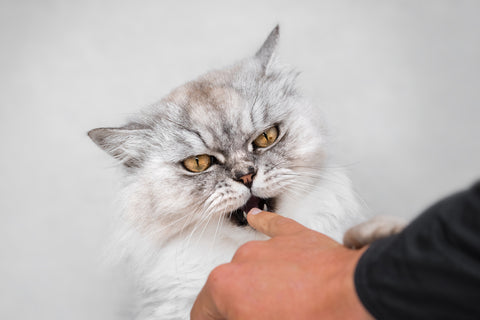
9. The Role of Diet in Potty Training
Diet plays an important role in your Persian cat’s overall health, including their potty training success. In this section, we will explore the significance of choosing the right cat food, considering wet or dry food options, managing water intake, incorporating high-fiber diets for regularity, and specialty diets for urinary health.
9.1 Choosing the Right Cat Food
Choosing the right cat food is crucial for your Persian cat’s health and potty training progress. Opt for high-quality cat food that meets their nutritional needs. Look for formulas that are specifically designed for adult cats and support urinary tract health. Consult with your veterinarian to ensure you are feeding your cat a balanced and appropriate diet.
9.2 Considering Wet or Dry Food Options
When it comes to wet or dry food options, both can be suitable for Persian cats. Wet food provides hydration and can be beneficial for cats who may not drink enough water. Dry food offers convenience and can promote dental health. A combination of both wet and dry food can provide a balanced diet for your Persian cat.
9.3 Managing Water Intake
Proper hydration is essential for your Persian cat’s overall health and well-being. Ensure they have access to fresh and clean water at all times. Some cats prefer running water, and utilizing a cat water fountain can help encourage water intake. During potty training, maintaining proper hydration can promote regular bathroom habits.
9.4 High-Fiber Diets for Regularity
Incorporating high-fiber diets can promote regular bowel movements and prevent constipation in your Persian cat. Look for cat food formulas that contain natural sources of fiber, such as pumpkin or psyllium husk. These ingredients can add bulk to the stool and aid in healthy elimination.
9.5 Specialty Diets for Urinary Health
Urinary health is crucial for Persian cats, as they are prone to urinary tract issues. Specialized cat food formulas designed for urinary health can help prevent urinary tract infections and support overall urinary tract function. These formulas usually have a balanced pH level and controlled mineral content to promote a healthy urinary system.
10. Frequently Asked Questions
10.1 How long does it take to potty train a Persian cat?
The duration of potty training can vary depending on your Persian cat’s individual progress and readiness. It can take anywhere from a few weeks to a few months to fully potty train your cat. Consistency, positive reinforcement, and patience are key during the training process.
10.2 Can I use a covered litter box for potty training?
Using a covered litter box for potty training can limit your Persian cat’s access and cause discomfort. It is generally recommended to use an open litter box during the training period. Once your cat is fully potty trained, you can slowly introduce a covered litter box if desired.
10.3 What if my Persian cat refuses to use the litter box?
If your Persian cat refuses to use the litter box, it’s important to investigate the underlying cause. Ensure that the litter box is clean and odor-free, and consider experimenting with different litter types or locations. If the issue persists, consult with a veterinarian or professional trainer for further guidance.
10.4 Should I punish my cat for accidents outside the litter box?
No, punishing your Persian cat for accidents outside the litter box is not recommended. Punishment can create fear and anxiety, potentially worsening the potty training process. Instead, focus on positive reinforcement and redirecting your cat to use the litter box consistently.
10.5 How often should I clean the litter box?
Cleaning the litter box regularly is essential for maintaining good potty habits and hygiene. Aim to scoop the litter box daily to remove waste and clumps. Deep clean the litter box with mild soap and water at least once a month. Regular cleaning prevents odors and ensures a clean and inviting environment for your Persian cat.
10.6 Can I potty train my Persian cat to use the toilet?
Potty training a Persian cat to use the toilet is possible but requires a considerable amount of time and effort. It involves gradually transitioning your cat from the litter box to a specially designed cat toilet training system. Consult with a professional trainer or behaviorist for guidance and support if you wish to pursue this method.
10.7 Are there any special considerations for potty training Persian kittens?
Potty training Persian kittens follows a similar process as training adult cats. However, it’s important to be mindful of their smaller size and physical abilities. Provide a litter box with low sides for easy entry and consider using litter specifically designed for kittens. Supervise their progress closely and adjust training techniques accordingly.
10.8 How do I prevent my Persian cat from developing litter box aversion?
Preventing litter box aversion in Persian cats involves ensuring a clean and odor-free litter box, using litter that your cat prefers, providing multiple litter boxes in different locations, and creating a calm and quiet environment around the litter box. Regularly scoop and clean the litter box to maintain cleanliness and avoid any negative associations.
10.9 Is a self-cleaning litter box a good option for Persian cats?
A self-cleaning litter box can be a convenient option for Persian cats and their owners. However, it’s important to consider your cat’s comfort and preferences. Some cats may be hesitant to use self-cleaning litter boxes due to the noise or movement. Introduce the self-cleaning litter box gradually and monitor your cat’s response.
10.10 Can I use puppy training pads for potty training?
While puppy training pads may seem like a convenient option, they are not recommended for potty training Persian cats. The texture and scent of the pads may differ from the litter box, causing confusion for your cat. It’s best to stick to traditional litter box training methods to ensure successful potty training.
